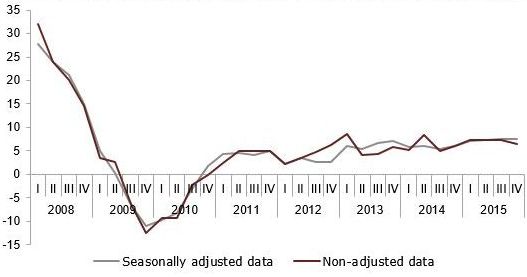Analytics, Financial Services, Labour-market, Latvia, Markets and Companies, Wages
International Internet Magazine. Baltic States news & analytics
Saturday, 20.04.2024, 05:23
In Q4, hourly labour costs in Latvia increased up to EUR 6.96
 Print version
Print version
The most notable increase in hourly labour costs was recorded in sectors, where level of labour costs was lower than average in the country: accommodation and food service activities – of 11.3%, real estate activities – of 10.2%, construction – of 9.5%, arts, entertainment and recreation – of 9.5%, as well as manufacturing – of 8.8%. Rise in these sectors was affected by growth in both wages and salaries and irregular premiums and bonuses. In manufacturing, construction, and real estate activities rise in hourly labour costs was also promoted by decrease in the number of hours worked.
 |
| Changes in hourly labour costs over the corresponding quarterof the previous year, % |
The smallest increase in hourly labour costs was observed in public administration – of 1.7%, slightly smaller drop was recorded in energy sector – of 3.0%, financial and insurance activities – of 3.7%, education – of 3.8%, as well as in professional, scientific and technical activities – of 3.9%.
In the 4th quarter of 2015, the highest hourly labour costs were registered in financial and insurance activities (EUR 14.37), information and communication services (EUR 11.17), energy sector (EUR 9.13), and public administration (EUR 8.91). Whereas the lowest hourly labour costs were recorded in accommodation and food service activities (EUR 4.63), other services sector (EUR 5.21), education (EUR 5.63), arts, entertainment and recreation (EUR 5.91), as well as administrative and support service activities (EUR 6.05).
Changes of hourly labour costs by main kind of economic activity (seasonally non-adjusted data; EUR)
|
|
Hourly labour costs |
of which wages and salaries |
||||
|
4th quarter of 2014
|
4th quarter of 2015
|
changes in% |
4th quarter of 2014
|
4th quarter of 2015
|
changes in% |
|
|
Total (B-S) |
6.53 |
6.96 |
6.4 |
5.24 |
5.60 |
6.8 |
|
Mining and quarrying (B) |
7.98 |
8.64 |
8.3 |
6.38 |
6.89 |
8.0 |
|
Manufacturing (C) |
6.13 |
6.67 |
8.8 |
4.91 |
5.34 |
8.7 |
|
Electricity, gas, steam and air conditioning supply (D) |
8.87 |
9.13 |
3.0 |
6.77 |
6.93 |
2.4 |
|
Water supply; sewerage, waste management and remediation activities (E) |
6.31 |
6.84 |
8.5 |
4.99 |
5.44 |
8.9 |
|
Construction (F) |
6.29 |
6.89 |
9.5 |
5.09 |
5.61 |
10.3 |
|
Wholesale and retail trade; repair of motor vehicles and motorcycles (G) |
5.63 |
6.09 |
8.3 |
4.53 |
4.92 |
8.5 |
|
Transportation and storage (H) |
7.17 |
7.58 |
5.7 |
5.74 |
6.05 |
5.4 |
|
Accommodation and food service activities (I) |
4.16 |
4.63 |
11.3 |
3.36 |
3.74 |
11.3 |
|
Information and communication (J) |
10.28 |
11.17 |
8.7 |
8.29 |
9.08 |
9.6 |
|
Financial and insurance activities (K) |
13.85 |
14.37 |
3.7 |
11.06 |
11.70 |
5.7 |
|
Real estate activities (L) |
5.58 |
6.15 |
10.2 |
4.51 |
5.01 |
11.1 |
|
Professional, scientific and technical activities (M) |
7.24 |
7.53 |
3.9 |
6.08 |
6.34 |
4.4 |
|
Administrative and support service activities (N) |
5.77 |
6.05 |
4.8 |
4.71 |
4.92 |
4.4 |
|
Public administration and defence, compulsory social security (O) |
8.76 |
8.91 |
1.7 |
6.80 |
7.00 |
2.9 |
|
Education (P) |
5.43 |
5.63 |
3.8 |
4.34 |
4.52 |
4.2 |
|
Health and social work (Q) |
5.95 |
6.27 |
5.3 |
4.78 |
5.04 |
5.6 |
|
Arts, entertainment and recreation (R) |
5.39 |
5.91 |
9.5 |
4.32 |
4.79 |
10.7 |
|
Other service activities (S) |
4.87 |
5.21 |
6.9 |
4.06 |
4.33 |
6.6 |
More information on labour costs in Latvia is available in the CSB database section Labour Costs – Key indicators. Statistics on labour costs in 2015 and 4th quarter of 2015 is published in database section ‘Labour costs’(Short term statistical data and Annual statistical data).
Methodological explanations
Labour costs include gross wages and salaries and other labour costs. Hourly labour costs are calculated by dividing the sum of labour costs by the number of hours worked.
Wages and salaries are regular and irregular direct wages and salaries – basic salary (monthly, wage), payment for the time worked or job completed, regular and irregular premiums and bonuses, payments for days not worked (vacation and other days not worked), state mandatory social insurance contributions paid by the employees, and personal income tax. In line with the regulatory enactment of the European Union (EU), when compiling data on labour costs, wages and salaries include remuneration in kind (goods and services provided by the employer to employees free of charge or at a lower price, living quarters, mobile telephone, transport compensation etc.). Other labour costs include statutory social security contributions payable by the employer, employers’ contractual and voluntary social security contributions (additional pension insurance contributions, health and life insurance contributions etc.), support payments from the employer, awards, gifts, payments for sick list A, severance pay, entrepreneurship state risk duty.
According to the EU regulatory enactments, hourly labour costs and changes thereof in this publication have been calculated for sectors B–S of the Statistical Classification of the Economic Activities (NACE) Rev. 2.
Indicator changes have been calculated from not rounded values.








 «The Baltic Course» Is Sold and Stays in Business!
«The Baltic Course» Is Sold and Stays in Business!

